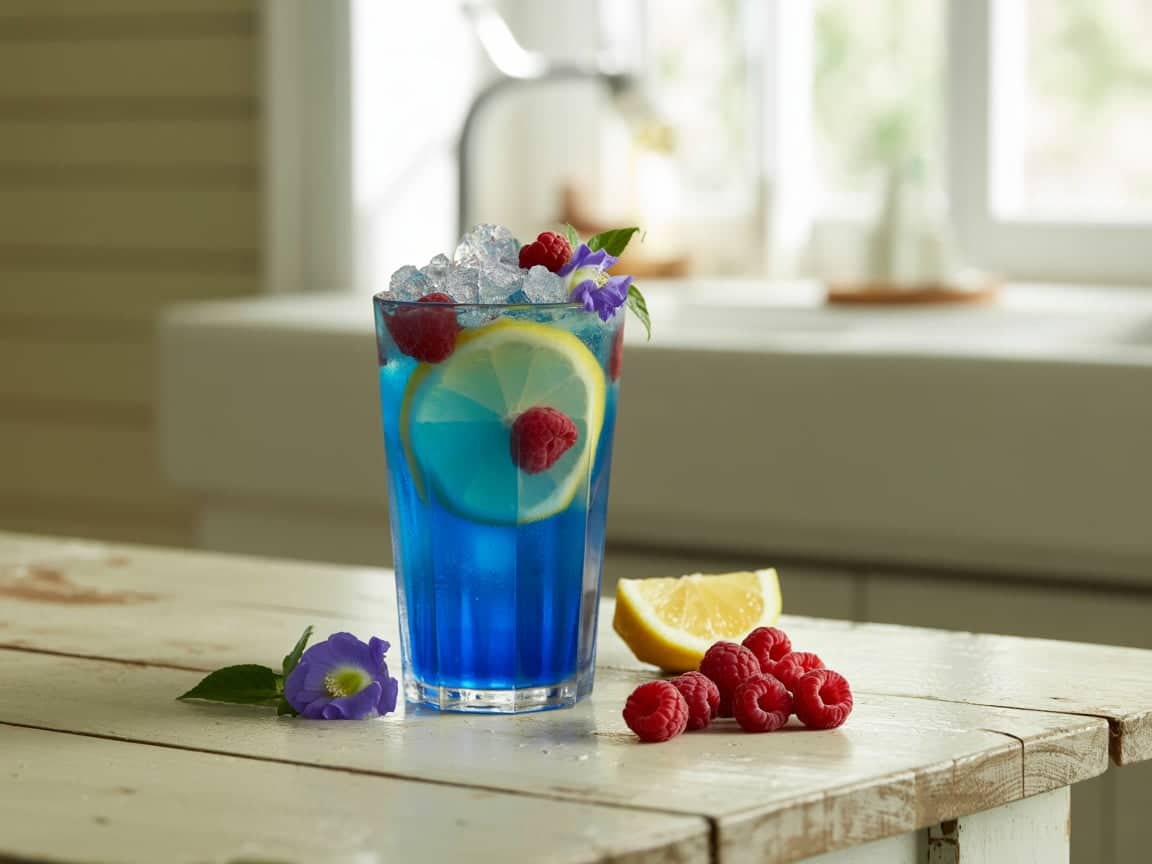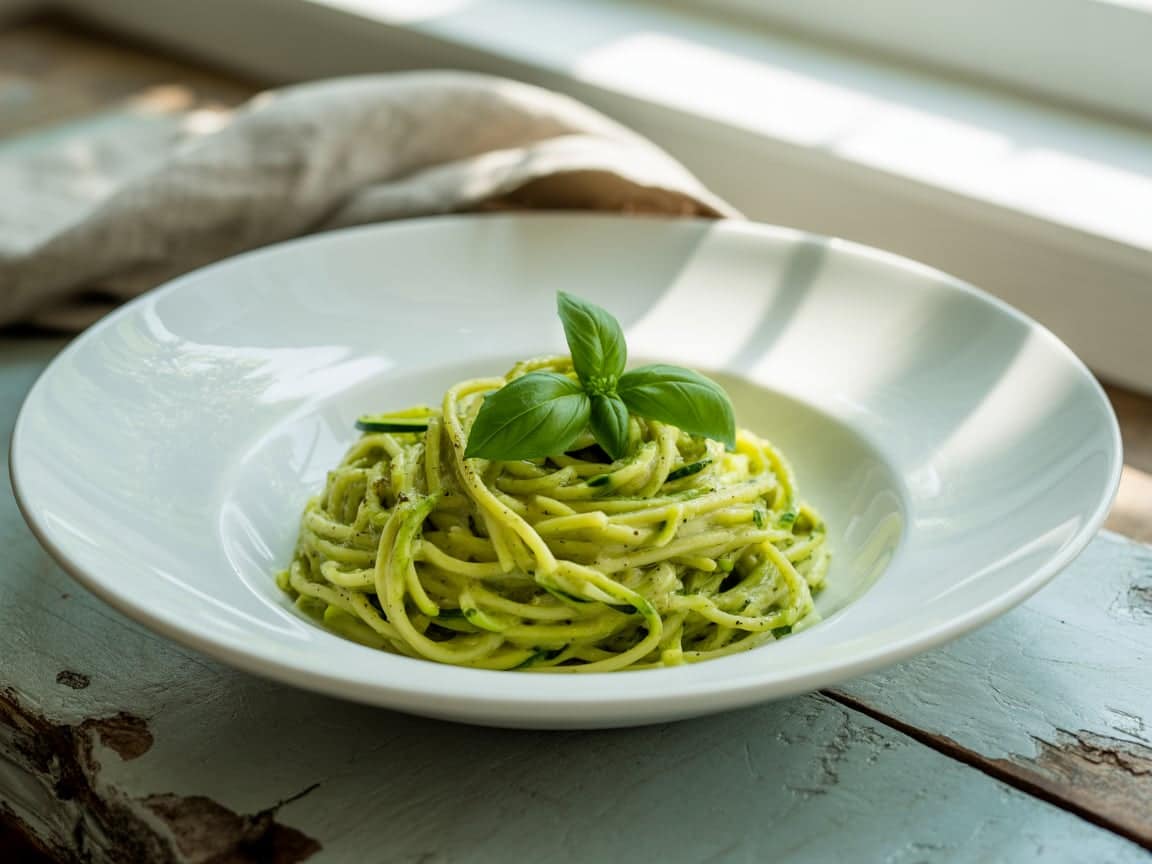Himalayan salt mouth rinse recipe — it might sound like a wellness trend, but in my cozy kitchen, it’s a cherished natural remedy passed down with love and intention. I’m Sarah, the heart behind CozyBitesRecipes.com, where I share comforting, everyday recipes inspired by family traditions and simple ingredients. My journey with cooking began in my grandmother’s kitchen, where healing didn’t just come from food—it came from the memories we made around the stove. Today, as a mom of two lively little ones, I continue that tradition by blending old wisdom with easy, practical recipes that nurture the body and soul.
Recently, while looking for gentle, natural ways to soothe my family’s occasional sore throats and promote better oral health, I revisited a remedy my grandmother swore by—a warm salt rinse. But not just any salt. I wanted something purer, richer in minerals, and more soothing on sensitive gums. That’s when I crafted my own Himalayan salt mouth rinse recipe, and let me tell you—it’s become a daily go-to in our home.
In this detailed guide, I’ll walk you through everything from the science behind salt rinses to step-by-step instructions for making your own Himalayan salt mouth rinse recipe, add-on ingredients for enhanced results, and FAQs that clear up common concerns. Whether you’re exploring this rinse for gum care, breath freshness, or natural remineralization, the Himalayan salt mouth rinse recipe is a simple, effective solution—and you’re in the right place.
Check out this salt-powered solution that’s as natural as it is nurturing: Pink Salt Recipe on CozyBitesRecipes
Let’s dive into the benefits and brilliance of using Himalayan salt for your oral health, starting with the basics.
Table of Contents
Understanding the Power of Himalayan Salt for Oral Health
What is Himalayan pink salt?
Himalayan pink salt is a mineral-rich salt harvested from the ancient sea beds of the Himalayan mountains, primarily in Pakistan. Unlike regular table salt, which is stripped of most of its nutrients and often bleached, Himalayan salt is unprocessed and naturally pink due to its high content of iron, calcium, magnesium, and potassium. These minerals aren’t just good for your body—they play a crucial role in oral health, too.
When it comes to natural remedies, pink salt is a game-changer. Its mineral content helps balance the mouth’s pH, reduce inflammation, and support gum tissue. That’s one reason so many people are turning to the Himalayan salt mouth rinse recipe for daily oral care. Its purity and therapeutic properties make it a gentle yet powerful addition to your hygiene routine.
Why Himalayan salt is different from regular table salt
You might wonder, “Can’t I just use regular salt?” The answer lies in the source and processing.
| Comparison | Himalayan Pink Salt | Table Salt |
|---|---|---|
| Processing | Unrefined, sun-dried | Heavily processed |
| Additives | None | Often contains anti-caking agents |
| Minerals | Over 80 trace minerals | Mostly sodium chloride only |
| Color | Natural pink hue | Pure white (bleached) |
Regular salt is effective for rinses in a pinch, but it lacks the soothing and remineralizing benefits found in a Himalayan salt mouth rinse recipe. For a holistic and nourishing oral rinse, Himalayan salt brings far more to the table—or, more appropriately, the sink.
Not only does the Himalayan salt mouth rinse recipe offer anti-bacterial and anti-inflammatory effects, but it also adds a sense of ritual and calm to your routine. There’s something truly grounding about using a substance so ancient and pure in your self-care.
Discover great ideas like this skin-friendly detox treatment: Easy Homemade Sugar Scrub
When choosing ingredients for any DIY recipe—especially for something as important as oral care—quality matters. And Himalayan pink salt? It doesn’t just cleanse. It heals.
Why Use a Himalayan Salt Mouth Rinse?
Proven benefits for oral hygiene
There’s a reason the Himalayan salt mouth rinse recipe has gained popularity among natural health enthusiasts—it works. Rinsing your mouth with warm salt water isn’t just a folk remedy; science backs it up. And when you use Himalayan pink salt, those benefits multiply thanks to its mineral profile.
Here are some key advantages:
- Reduces harmful bacteria: Salt draws moisture from bacteria cells through osmosis, effectively killing them or slowing their growth.
- Helps heal wounds: Got a canker sore, gum irritation, or post-dental procedure tenderness? Salt water promotes faster healing by soothing tissues and reducing swelling.
- Balances oral pH: A balanced pH helps create a less hospitable environment for plaque and cavity-causing bacteria.
- Freshens breath: Regular use helps neutralize odor-causing bacteria without the harsh chemicals found in commercial rinses.
Many users who adopt a Himalayan salt rinse report reduced bleeding gums, fewer breakouts around the mouth, and a fresher breath that lasts throughout the day.
Don’t miss our natural liver-cleansing drink packed with detox power: Liver Flush Juice Recipe
Comparison: Himalayan salt rinse vs. commercial mouthwash
| Feature | Himalayan Salt Rinse | Commercial Mouthwash |
|---|---|---|
| Main ingredients | Pink salt + warm water | Alcohol, chlorhexidine, synthetic flavors |
| Safety for daily use | Safe & natural | Long-term use may cause irritation |
| Remineralization | Contains natural trace minerals | Lacks natural minerals |
| Cost | Inexpensive | Can be costly over time |
| Environmental impact | Minimal waste | Often plastic packaging |
Unlike store-bought mouthwashes that may contain dyes, alcohol, and artificial preservatives, a Himalayan salt mouth rinse recipe is as clean as it gets. Plus, you can make it in under two minutes with ingredients already in your pantry.
Looking for inspiration? Try this herbal healing recipe too: Lemon Balm Recipe
Not only does the Himalayan salt mouth rinse recipe support gum health, but it also aligns beautifully with a minimalist, toxin-free lifestyle. Whether you’re embracing clean living or simply want to cut back on unnecessary additives, this natural rinse is a smart, simple solution.
The Science Behind Salt Water Rinses
How salt water affects bacteria and oral pH
Salt has been used for centuries as a natural antimicrobial agent. When you use a Himalayan salt mouth rinse recipe, you’re tapping into this age-old healing wisdom—enhanced by the purity and mineral content of Himalayan salt.
Here’s how it works:
- Osmosis: Salt water creates a hypertonic environment, meaning it draws moisture out of microbial cells. This dehydrates and kills many forms of harmful bacteria that cause bad breath, cavities, and gum infections.
- pH balance: A rinse made with Himalayan salt helps balance your mouth’s pH levels. Why does this matter? A more neutral or slightly alkaline oral environment reduces acid erosion, plaque buildup, and enamel damage.
- Reduces biofilm: Biofilm is a sticky layer of bacteria on your teeth and gums. Salt water disrupts its formation, keeping your mouth cleaner for longer.
In short, this rinse doesn’t just rinse away food—it fights bacteria, rebalances, and resets your oral health.
Salt rinse for wound healing, inflammation, and gum care
Whether you’re recovering from a dental procedure or dealing with inflamed gums, a Himalayan salt mouth rinse can bring powerful relief.
Let’s break down the benefits:
- Reduces gum swelling: Thanks to its anti-inflammatory properties, a warm pink salt rinse can reduce swelling in gums caused by irritation, gingivitis, or accidental flossing injuries.
- Soothes oral wounds: Have a cut, sore, or surgical site? A salt rinse gently cleanses the wound without stinging or disrupting healing tissue.
- Improves circulation: Some studies suggest salt water rinsing may improve blood flow to oral tissues, promoting faster recovery and overall gum strength.
| Symptom | How Salt Rinse Helps |
|---|---|
| Swollen gums | Reduces inflammation & bacteria |
| Mouth sores | Cleanses and promotes healing |
| Tooth extraction | Keeps wound clean without harsh chemicals |
| Sensitive areas | Soothes with gentle mineral balance |
Check out this naturally-inspired remedy that supports wellness inside and out: Natural Zepbound Recipe
Many dentists still recommend a warm salt water rinse post-surgery for one reason: it works. And when you follow a Himalayan salt mouth rinse recipe, you give your mouth an even more mineral-rich advantage with added soothing and healing properties.
Step-by-Step Himalayan Salt Mouth Rinse Recipe
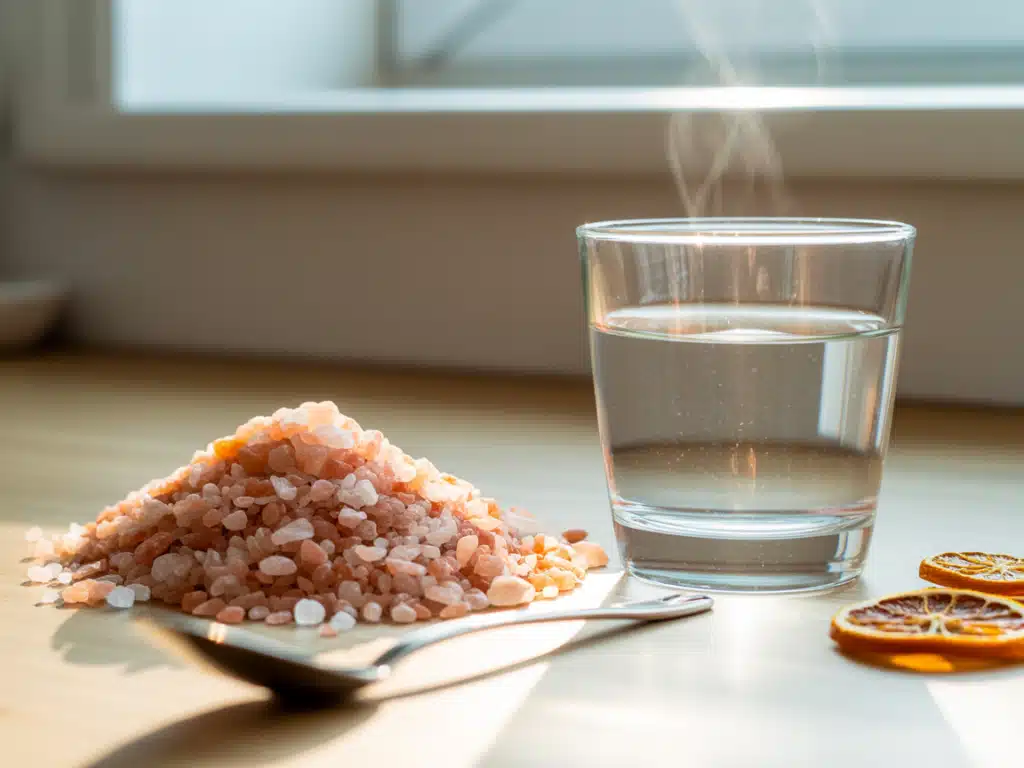
Simple DIY Himalayan salt mouth rinse recipe
Creating your own Himalayan salt mouth rinse recipe takes less than two minutes, but it delivers long-lasting oral benefits. You don’t need fancy equipment—just a few clean ingredients and a glass.
Here’s a simple, tried-and-true recipe straight from my cozy kitchen.
Ingredients:
| Ingredient | Amount | Purpose |
|---|---|---|
| Himalayan pink salt (fine grain) | ½ tsp | Antibacterial & mineral support |
| Warm filtered water | 1 cup (8 oz) | Soothing base for rinsing |
Instructions:
- Warm the water: Heat 1 cup of filtered water until it’s warm—not boiling. Think baby bottle warm—just enough to dissolve the salt without harming sensitive mouth tissue.
- Add the salt: Stir in ½ teaspoon of Himalayan pink salt. Mix until fully dissolved.
- Rinse: Take a small sip (about 2 tablespoons), swish in your mouth for 30 seconds, and spit. Repeat until the cup is empty.
- Don’t swallow the solution—it’s not meant for ingestion.
- Optional: Use a clean jar to store the remaining rinse. It will keep for 1-2 days at room temperature, but it’s best fresh.
You’ve just made an effective, natural oral rinse using two simple ingredients. For freshness, you can prepare a new batch each morning or evening.
Don’t miss our recipe that shares a similar natural simplicity and care: Natural Mounjaro Recipe
How to make a concentrated salt rinse safely at home
If you want a more powerful mouth rinse—say, for post-dental care or more intense gum irritation—you can make a concentrated version of this recipe. But remember: more salt doesn’t always mean better results.
Here’s how to increase strength safely:
- Use ¾ to 1 teaspoon of Himalayan salt per cup of warm water.
- Stir thoroughly to dissolve completely.
- Test a small rinse first—if it stings or feels too intense, dilute with more water.
Be cautious with high concentrations. Using too much salt too often may irritate the tissues instead of helping them heal. A mild to medium solution is ideal for most daily uses.
| Concentration | Salt | Water | Use |
|---|---|---|---|
| Mild (daily use) | ½ tsp | 1 cup | General oral care |
| Medium | ¾ tsp | 1 cup | Occasional gum soreness |
| Strong | 1 tsp | 1 cup | Short-term use only for acute healing |
With this Himalayan salt mouth rinse recipe, you’re not just cleaning your mouth—you’re honoring a tradition of natural wellness that’s gentle, affordable, and effective.
Step-by-Step Himalayan Salt Mouth Rinse Recipe
Simple DIY Himalayan salt mouth rinse recipe
Creating your own Himalayan salt mouth rinse recipe takes less than two minutes, but it delivers long-lasting oral benefits. You don’t need fancy equipment—just a few clean ingredients and a glass.
Here’s a simple, tried-and-true recipe straight from my cozy kitchen.
Ingredients:
| Ingredient | Amount | Purpose |
|---|---|---|
| Himalayan pink salt (fine grain) | ½ tsp | Antibacterial & mineral support |
| Warm filtered water | 1 cup (8 oz) | Soothing base for rinsing |
Instructions:
- Warm the water: Heat 1 cup of filtered water until it’s warm—not boiling. Think baby bottle warm—just enough to dissolve the salt without harming sensitive mouth tissue.
- Add the salt: Stir in ½ teaspoon of Himalayan pink salt. Mix until fully dissolved.
- Rinse: Take a small sip (about 2 tablespoons), swish in your mouth for 30 seconds, and spit. Repeat until the cup is empty.
- Don’t swallow the solution—it’s not meant for ingestion.
- Optional: Use a clean jar to store the remaining rinse. It will keep for 1-2 days at room temperature, but it’s best fresh.
You’ve just made an effective, natural oral rinse using two simple ingredients. For freshness, you can prepare a new batch each morning or evening.
Don’t miss our recipe that shares a similar natural simplicity and care: Natural Mounjaro Recipe
How to make a concentrated salt rinse safely at home
If you want a more powerful mouth rinse—say, for post-dental care or more intense gum irritation—you can make a concentrated version of this recipe. But remember: more salt doesn’t always mean better results.
Here’s how to increase strength safely:
- Use ¾ to 1 teaspoon of Himalayan salt per cup of warm water.
- Stir thoroughly to dissolve completely.
- Test a small rinse first—if it stings or feels too intense, dilute with more water.
Be cautious with high concentrations. Using too much salt too often may irritate the tissues instead of helping them heal. A mild to medium solution is ideal for most daily uses.
| Concentration | Salt | Water | Use |
|---|---|---|---|
| Mild (daily use) | ½ tsp | 1 cup | General oral care |
| Medium | ¾ tsp | 1 cup | Occasional gum soreness |
| Strong | 1 tsp | 1 cup | Short-term use only for acute healing |
With this Himalayan salt mouth rinse recipe, you’re not just cleaning your mouth—you’re honoring a tradition of natural wellness that’s gentle, affordable, and effective.
Additional Ingredients to Boost Your Salt Rinse
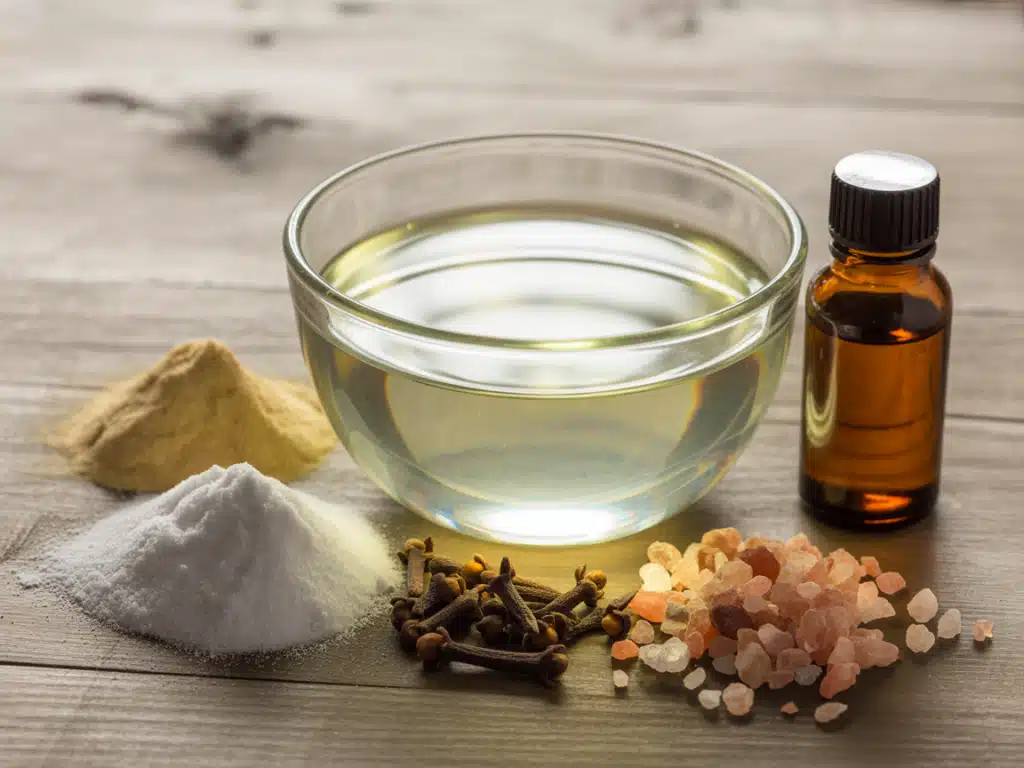
Add-ons like baking soda, essential oils, and herbs
While the Himalayan salt mouth rinse recipe works beautifully on its own, you can tailor it to your specific oral needs by adding simple, natural ingredients that boost its power.
Here are some safe and effective add-ons you can mix in:
1. Baking Soda (½ tsp)
- Why add it? It helps neutralize acids and whiten teeth.
- Bonus: Baking soda also softens plaque and freshens breath.
- How to use: Mix it with the salt before dissolving in warm water.
2. Tea Tree or Peppermint Essential Oil (1 drop)
- Why add it? These oils are naturally antimicrobial and provide a refreshing aftertaste.
- Caution: Use therapeutic-grade essential oils only, and never more than one drop per cup.
- How to use: Add oil after the salt has fully dissolved.
3. Aloe Vera Juice (1 tsp)
- Why add it? Aloe is soothing and supports gum healing.
- Great for: Sensitive mouths, gingivitis, or after dental work.
4. Clove Powder (a pinch)
- Why add it? Clove has natural numbing and antibacterial properties.
- Use sparingly: It has a strong taste but works wonders for sore gums.
5. Chamomile or Mint Tea (as base water)
- Why add it? Replace warm water with a mild herbal tea for added anti-inflammatory benefits.
- How to use: Brew tea, let it cool to warm, and add salt as usual.
Optional ingredient combinations for extra benefits
You can easily mix and match depending on your needs. Here are a few tested combos that have worked great for me and readers in the CozyBitesRecipes community:
| Purpose | Recipe Combo |
|---|---|
| Everyday Refresh | ½ tsp pink salt + warm water + 1 drop peppermint oil |
| Whitening Support | ½ tsp pink salt + ½ tsp baking soda + warm water |
| Post-Dental Care | ½ tsp salt + 1 tsp aloe vera juice + chamomile tea |
| Sore Gum Relief | ½ tsp salt + pinch of clove powder + warm mint tea |
Keep your add-ons minimal and safe—especially with essential oils. Always test new ingredients in small amounts, and consult your dentist if you have ongoing oral health issues.
Discover great ideas like this homemade DIY care recipe for external detox too: Easy Homemade Sugar Scrub
With these natural boosters, your Himalayan salt mouth rinse recipe becomes even more versatile, letting you customize based on your daily oral care needs or concerns.
Print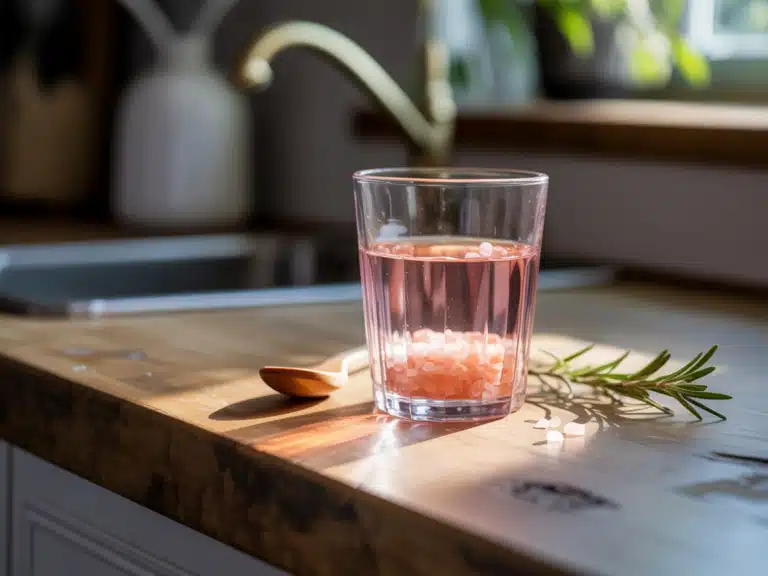
Himalayan Salt Mouth Rinse Recipe
Himalayan salt mouth rinse recipe for gum healing, breath freshening, and oral detox.
- Total Time: 2 minutes
- Yield: 1 cup 1x
Ingredients
½ tsp Himalayan pink salt
1 cup warm filtered water
Instructions
Heat water until warm, not boiling.
Add salt and stir until fully dissolved.
Swish in mouth for 30 seconds, then spit.
Notes
Storage: Use fresh daily or store in a sealed jar for up to 48 hours.
Add-ons (optional): baking soda, peppermint oil, aloe juice
- Prep Time: 2 minutes
Nutrition
- Serving Size: 1 cup
Safety Tips and Things to Avoid
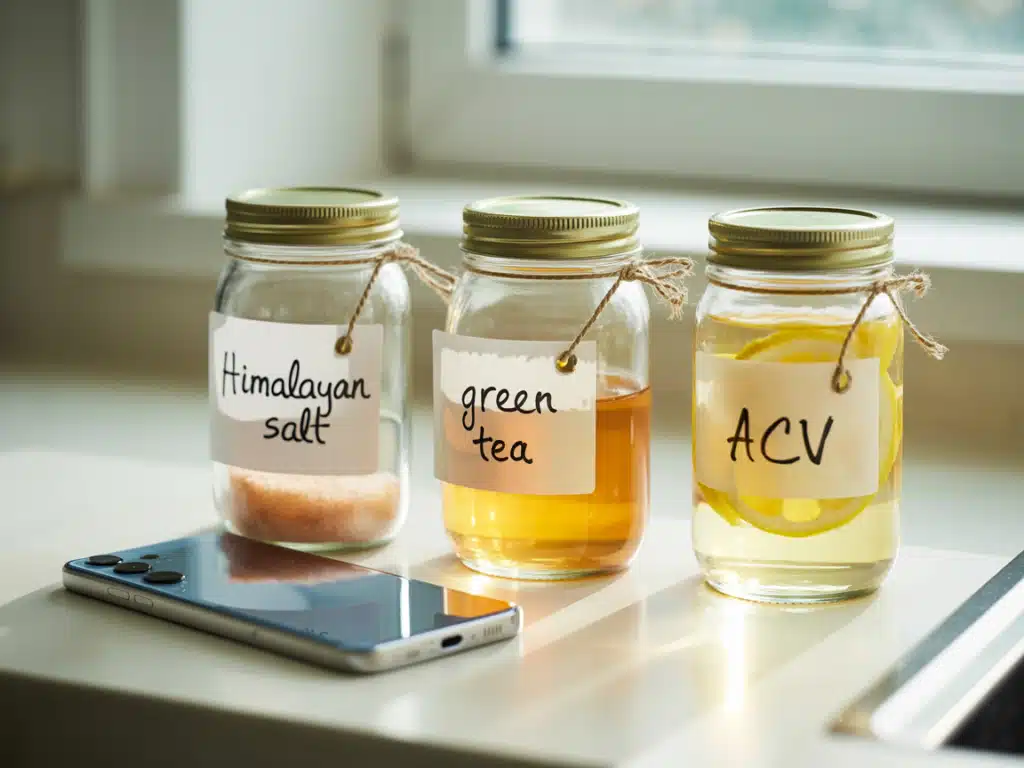
Risks of overuse or wrong salt concentrations
While the Himalayan salt mouth rinse recipe is incredibly gentle and natural, it’s still important to use it correctly. Like any remedy, balance is key. Overuse or overly strong solutions can cause more harm than good—especially if you have sensitive gums or dental concerns.
Here are a few things to keep in mind:
- Don’t use more than 1 teaspoon per cup unless advised by a professional. Too much salt can irritate your mouth and throw off your body’s fluid balance if used excessively.
- Avoid swallowing the rinse, especially if you’ve added essential oils or baking soda. It’s meant for swishing, not sipping.
- Stick to filtered or boiled water to avoid introducing harmful bacteria, especially if storing your rinse overnight.
- Use fine grain pink salt, not coarse crystals. Coarse salt may not dissolve well and could cause abrasions on delicate tissue.
If you experience ongoing stinging, sensitivity, or dry mouth, reduce the concentration or consult your dentist before continuing use.
Common mistakes people make when using salt rinses
Making your own Himalayan salt mouth rinse recipe is empowering—but it’s easy to overlook some simple rules. Here are the most frequent mistakes I’ve seen from readers and even in my own early experimenting:
| Mistake | Why It’s a Problem | Quick Fix |
|---|---|---|
| Using too hot water | Can burn mouth tissue | Use warm, not hot, water (like bathwater temp) |
| Rinsing too quickly | Won’t reach all areas | Swish for a full 30 seconds |
| Not dissolving salt fully | Salt crystals can irritate gums | Stir until completely clear |
| Skipping brushing/flossing | Rinse isn’t a replacement | Use as part of a complete routine |
| Overusing essential oils | May cause allergic reactions or burning | Start with 1 drop only |
Check out another gentle and healing recipe designed for sensitive bodies: Banana Peach Smoothie Recipe
By staying mindful of these simple safety practices, your Himalayan salt mouth rinse recipe will remain a beneficial and safe addition to your wellness routine.
Real Experiences & Natural Oral Care Alternatives
Testimonials and natural oral care routines
One of the best parts about sharing the Himalayan salt mouth rinse recipe is hearing how it’s helped others reclaim their oral health naturally. From readers who’ve ditched alcohol-based mouthwashes to those looking for gentle recovery post-dental procedures, the feedback has been inspiring.
Here are a few real-world experiences from the CozyBitesRecipes community:
Emma, 34 (California):
“I had recurring gum inflammation, and my dentist suggested salt rinses. I switched to pink Himalayan salt after reading your recipe and WOW. Within a week, the soreness eased, and my breath felt fresher all day.”
James, 47 (Texas):
“Commercial rinses left my mouth dry and irritated. Your DIY salt rinse—especially the version with aloe—was a total game changer. I now use it every night before bed.”
Lena, 29 (New York):
“I love that it’s budget-friendly and toxin-free. I use it every morning after brushing. Bonus: I feel more in control of my health without needing to buy specialty products.”
These testimonials echo what many natural wellness lovers already believe—less is more, and when you use the right ingredients, your body responds beautifully.
Other homemade mouthwash options using kitchen ingredients
If you enjoy the Himalayan salt mouth rinse recipe, you might also love exploring other homemade mouthwash recipes that use easy, natural pantry staples. They complement your routine and offer variety while avoiding harsh chemicals.
Here are a few safe, simple options:
1. Apple Cider Vinegar Rinse
- 1 tsp raw ACV + 1 cup water
- Kills bacteria and helps whiten teeth
- Use sparingly to avoid enamel erosion
2. Green Tea Mouthwash
- Brewed, cooled green tea (no sugar) + pinch of salt
- Rich in antioxidants and reduces gum inflammation
3. Hydrogen Peroxide Rinse
- ½ cup water + ½ cup 3% hydrogen peroxide (use occasionally)
- Helps whiten teeth and disinfect
4. Coconut Oil Pulling
- 1 tbsp organic coconut oil swished for 10–15 minutes
- Removes bacteria, improves gum health, and freshens breath
| Natural Rinse | Best For |
|---|---|
| Salt rinse (Himalayan) | Daily oral hygiene |
| ACV rinse | Periodic detox, breath freshening |
| Green tea rinse | Inflammation and gum support |
| Oil pulling | Deep cleansing and whitening |
| Peroxide rinse | Stain removal and microbial control |
These natural solutions can work hand-in-hand with your Himalayan salt mouth rinse recipe, giving you a clean, safe, and empowered oral care routine—without synthetic additives.
Looking for inspiration? Try another natural remedy that supports internal wellness too: Chia Seeds Smoothie
FAQs – Himalayan Salt Mouth Rinse Recipe
Is Himalayan pink salt good for mouth rinse?
Yes, Himalayan pink salt is excellent for a mouth rinse. Unlike processed table salt, Himalayan salt contains over 80 trace minerals that help soothe gums, reduce inflammation, and promote healing. When used in a Himalayan salt mouth rinse recipe, it offers a natural antibacterial effect without the dryness or irritation caused by alcohol-based mouthwashes. Its mineral content also supports remineralization and pH balance in the mouth.
How do you make Himalayan salt mouthwash?
To make your own Himalayan salt mouth rinse recipe, dissolve ½ teaspoon of fine pink salt in 1 cup of warm filtered water. Swish about 1–2 tablespoons in your mouth for 30 seconds, then spit. You can use it once or twice a day as part of your oral care routine. For extra benefits, add ingredients like baking soda or peppermint oil (in very small amounts).
Should you brush your teeth before or after a salt water rinse?
It depends on your preference and goals. If you rinse before brushing, it helps loosen debris and reduce bacteria load before cleaning. If you rinse after brushing, it offers soothing benefits and can help heal gum tissue or neutralize leftover acidity. Many users alternate or rinse both before and after brushing when using the Himalayan salt mouth rinse recipe.
Can Himalayan salt remineralize teeth?
Himalayan salt contributes trace minerals like calcium, magnesium, and potassium that may help support enamel health and remineralization when used regularly. While it’s not a substitute for fluoride or professional treatments, a consistent Himalayan salt mouth rinse recipe can create a healthier environment in the mouth by balancing pH and reducing harmful bacteria—both essential for enamel preservation.
Conclusion: Embrace the Natural Power of a Himalayan Salt Mouth Rinse Recipe
Creating and using a Himalayan salt mouth rinse recipe is one of the simplest and most effective ways to support your oral health naturally. From reducing inflammation to fighting bacteria and promoting healing, pink salt delivers powerful benefits with none of the harsh chemicals found in commercial rinses.
Whether you’re seeking a gentle rinse after dental work, looking to improve your gum health, or just want a daily natural solution, the Himalayan salt mouth rinse recipe is a go-to in homes like mine. This Himalayan salt mouth rinse recipe is affordable, easy to make, and rooted in age-old wisdom—making it a trusted ally in your clean-living routine.
Looking for more holistic health recipes? Don’t miss our soothing wellness blend here: Pink Salt Recipe on CozyBitesRecipes


